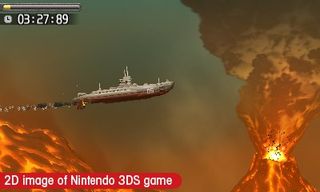The Top 7... Things we hate about modern gaming
We lead a frivolous, dreamlike lifestyle – and here’s everything we hate about it!
5 %26ndash; Sony%26rsquo;s cripplingly long updates

Aggravating as the Wii may be, at least it lets us play games whenever we damn well please. Meanwhile, how many times in the past few years have you sat down to play Uncharted or watch Netflix/Hulu and had to sit through a tortuously long firmware update that cannot download in the background? Oh we’re sorry, did you want to come home and relax with Flower? Well NOT FOR 20 MINUTES, AND YOU WILL ENJOY THE NEW ABILITY TO UPLOAD PHOTOS TO PICASA.

Above: SWEET I CAN FINALLY UPLOAD PHOTOS TO PICASA
Then there’s PSP, which periodically forces you to update firmware in order to play the newest games. In theory, not that big of a hassle – but if you haven’t played your PSP in a while and the battery is dead, the system forces you to charge it for X minutes before you can even begin to install the new firmware. So that’s wait time for a charge (even if the system is plugged into the goddamn wall) and then you get to sit through an install. How is this thing portable, again?
Oh, our favorite update of all time? That’d be 1.60, which gave us the ability to finally download content in the background. Naturally, you cannot download that update in the background. Or several other updates for the next four years. Thanks!
4 %26ndash; Mobile games vs console games

You know what we like? Games. Know what we don’t like? Constant bickering about which sector of gaming is going to die next. People have predicted the end of PC gaming for years – it’s still here. Now the go-to argument is the role of mobile games in the modern world. Angry Birds dev Rovio got one game right and now thinks it has the right to say console gaming is dying, while Nintendo counters by saying low-budget mobile games are the “biggest risk” to the entire games industry. Clearly neither of these companies has a stake in the issue so we can assume both arguments are 100% accurate...
Meanwhile, we’d like to say there’s room for both; we don’t want a stunning, console-quality game on our phone, nor do we need $1.00 throwaway games blown up on our TV screens. There’s a time and place for both approaches, and the availability of both enriches the entire gaming experience. Airports, buses, trains, road trips, doctors’ offices, even bathrooms (oh you do it too) are perfect for hits like Angry Birds, Cut the Rope, Infinity Blade and Game Dev Story, but in those instances we’re not about to dive into a 40-hour epic offered on a handheld from Nintendo or Sony.

Above: The middle ground - $40 games that last 5 hours - isn’t much better
Sign up to the 12DOVE Newsletter
Weekly digests, tales from the communities you love, and more
And that’s the real challenge facing those two – can 3DS and NGP compete with $30-40 games in a world that’s increasingly content with a $5 games that play on phones people already own? We’re going to be there day one to see what Sony offers with its next handheld, but there’s a part of us that already knows we’ll play it more at home than on the road. In that case, it’s not console games or mobile games that should worry – it’s the in-between world of 3DS and NGP that may have to adapt or die.
3 %26ndash; Broken, buggy games
When game consoles first started getting hard drives and always-on internet connections, many console gamers were too excited to see a downside. PC gamers had been down that path before, however, and they knew what lay ahead. Some tried to warn us, saying the PC market had devolved into one where publishers felt justified in releasing broken products, because they knew they could fix them later with patches and updates. But we didn’t listen. After all, hadn’t console-game publishers always taken a more stringent approach to quality control than their unfettered PC counterparts?

Above: There’s no way something this shiny could have technical problems, right?
It turned out quality control existed only because console publishing didn’t offer a second chance to get it right. After a few years of consoles that have more in common with PCs than with dedicated game machines, patches – particularly day-one patches – have gradually become an accepted part of gaming, and it’s not uncommon to have to sit through a lengthy download before you can even play some games for the first time (we’re looking at you, SOCOM 4). It’s getting pretty irritating, but what’s even worse is the alternative: putting up with the shit those patches address.

Above: Granted, this Fallout: New Vegas glitch is more amusing than upsetting, but it’s difficult to depict a freeze, crash or corrupted save with a screenshot
It’s great, for example, that automatic patches have fixed the insulting load times in the PS3 version of Bayonetta, or (most of) the rampant instability of Fallout: New Vegas, but the fact that those high-profile, $60 games shipped with major problems in the first place is inexcusable. Hitting a release date shouldn’t be more important than delivering a working product, and hearing “we’ll fix it later” is cold comfort to those who shelled out full price for a game on launch day. And yet it’s becoming more and more common for console gamers to not only accept these flaws, but in some cases actually defend them when others complain.
On the PC front, the situation has gotten bad enough that it’s now considered stupid to buy a new game before the bugs have been ironed out. Are consoles headed in the same direction? So long as publishers see early adopters as an inexpensive replacement for their QA departments, and so long as gamers put up with it, the answer seems to be yes.
12DOVE was first founded in 1999, and since then has been dedicated to delivering video game-related news, reviews, previews, features, and more. Since late 2014, the website has been the online home of Total Film, SFX, Edge, and PLAY magazines, with comics site Newsarama joining the fold in 2020. Our aim as the global GamesRadar Staff team is to take you closer to the games, movies, TV shows, and comics that you love. We want to upgrade your downtime, and help you make the most of your time, money, and skills. We always aim to entertain, inform, and inspire through our mix of content - which includes news, reviews, features, tips, buying guides, and videos.
Bloodborne still seems a long way from getting an official 60fps port, but fans have finally gotten PS4 emulators to deliver the remaster they’ve wanted for years
Ultima creator Richard Garriott considered a tabletop version of the pioneering open-world RPG series but isn't sure it would sell: "May be worth finding out"
Most Popular
